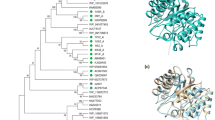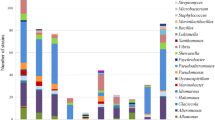Abstract
Xylanases (EC3.2.1.8) catalyze the hydrolysis of xylan, the major constituent of hemicellulose. The use of these enzymes could greatly improve the overall economics of processing lignocellulosic materials for the generation of liquid fuels and chemicals. The hyperthermophilic archaeon Pyrodictium abyssi, which was originally isolated from marine hot abyssal sites, grows optimally at 97°C and is a prospective source of highly thermostable xylanase. Its endoxylanase was shown to be highly thermostable (over 100 m in at 105°C) and active even at 110°C. The growth of the deep-sea archaeon P. abyssi was investigated using different culture techniques. Among the carbohydrates used, beech wood xylan, birch wood glucuronoxylan and the arabinoxylan from oats pelt appeared to be good inducers for endoxylanase and β-xylosidase production. The highest production of arabinofuranosidase, however, was detected in the cell extracts after growth on xylose and pyruvate, indicating that the intermediate of the tricarboxylic acid cycle acted as a nonrepressing carbon source for the production of thi enzyme. Electron microscopic studies did not show a significant difference in the cell surface (e.g., xylanosomes) when P. abyssi cells were grown on different carbohydrates. The main kinetic parameters of the organism have been determined. The cell yield was shown to be very low owing to incomplete substrate utilization, but a very high maximal specific growth rate was determined (μmax=0.0195) at 90°C and pH 6.0. We also give information on the problems that arise during the fermentation of this hyperthermophilic archaeon at elevated temperatures.
Similar content being viewed by others
Abbreviations
- B :
-
Contois apparent saturation constant
- diag(M):
-
vector extracted from main diagonal of generic matrix M
- J :
-
Jacobian matrix of estimated parameters
- K g :
-
Monod saturation constant
- K g :
-
tessier apparent saturation constant
- n :
-
number of responses
- p :
-
number of parameters
- S :
-
substrate concentration
- S R 2 :
-
estimate of error variance
- t :
-
time
- t γ,1−α/2 :
-
t-Student abscissa for v degrees of freedom at the significance level α/2
- X :
-
cell mass concentration
- y :
-
experimental response variable (cell mass or substrate concentration)
- y :
-
estimated response variable
- y :
-
estimated responses vector
- Y X/S :
-
cell mass yield factor
- \(\hat \beta \) :
-
estimated parameters vector
- η:
-
correct responses vector
- μmax :
-
maximum specific uptake rate
- σ 2ε :
-
error variance
References
Pley, U., Schipka, J., Gambacorta, A., Jannasch, H., Fricke, H., Rachel, R., and Stetter, K. O. (1991), System. Appl. Microbiol. 14, 245–253.
Antranikian, G. and Sjøholm, C. (1997), US Patent no. 05688668.
Antranikian, G. and Sjøholm, C. (1999), US Patent no. 05912150.
Andrade, C. M. M. C., Pereira, N. Jr., and Antranikian, G. (1999), Rev. Microbiol. 30, 325–336.
Stetter, K. O. (1996), FEMS Microbiol. Rev. 18, 149–158.
Halio, S. B., Blumentals, I. I., Short, S. A., Merrill, B. M., and Kelly, R. M. (1996), J. Bacteriol., 178(9), 2605–2612.
Kengen, S. W. M., Stams, A. J. M., and de Vos, W. M. (1996), FEMS Microbiol. Rev. 18, 119–137.
Krahe, M., Antranikian, G., and Märkl, H. (1996), FEMS Microbiol. Rev. 18, 271–285.
Stetter, K. O., König, H., and Stackebrandt, E. (1983), System. Appl. Microbiol. 4, 535–551.
Somogyi, M. (1952), J. Biol. Chem. 195, 19–23.
Miller, G. L. (1969), Anal. Chem. 31, 426–428.
Bradford, M. (1976), Anal. Biochem. 72, 248–254.
Canganella, F., Andrade, C. M., and Antranikian, G. (1994), Appl. Microbiol. Biotechnol. 42, 239–245.
Schauder, R. and Kröger, A. (1993), Arch. Microbiol. 159, 491–497.
Garcia, B. L., Ball, A. S., Rodriguez, J., Perez-Leblic, M. I., Arias, M. E., and Copa-Patino, J. L. (1998), FEMS Microbiol. Lett. 158(1), 95–99.
Hostalka, F., Moultrie, A., and Stutzenberger, F. (1992), J. Bacteriol. 174(21), 7048–7052.
Damaso, M. C. T., Andrade, C. M., and Pereira, N. Jr. (2000), Appl. Biochem. Biotechnol. 84–86, 1–14.
Schyns, P. J. Y. M. J. and Stams, A. J. M. (1992), in Xylan and Xylanases, Visser, J., Beldman, G., Kusters-van Someren, M. A., and Voragen, A. G. J. eds., Elsevier Science, Amsterdam, pp. 295–300.
Kristufek, D., Zeilinger, S., and Kubicek, C. P. (1995), Appl. Microbiol. Biotechnol. 42, 713–717.
Adamsen, A. K., Lindhagen, J., and Ahring, B. K. (1995), Appl. Microbiol. Biotechnol. 44, 327–332.
Xu, J. P., Nogawa, M., Okada, H., and Morikawa, Y. (1998), Biosci. Biotechnol. Biochem. 62(8), 1555–1559.
Gobbetti, M., Lavermicocca, P., Minervini, F., De Angelis, M., and Corsetti, A. (2000), J. Appl. Microbiol. 88(2), 317–324.
McMillan, J. D. and Boynton, B. L. (1994), Appl. Biochem. Biotechnol. 45/46, 569–582.
Cook, G. M., Janssen, P. H., Russel, J. B., and Morgan, H. W. (1994), FEMS Microbiol. Lett. 116, 257–262.
Biesterveld, S., Kok, M. D., Dijkema, C., Zehnder, J. B., and Stams, A. J. M. (1994), Arch. Microbiol. 161, 521–527.
Nakanishi, K., Marui, M., and Yasui, T. (1992), J. Ferment. Bioeng. 74, 392–394.
Khasin, A., Alchanati, I., and Shoham, Y. (1993), Appl. Environ. Microbiol. 59(6), 1725–1730.
Bérenger, J. F., Frixon, C., Bigliardi, J., and Creuzet, N. (1985), Can. J. Microbiol. 31, 635–643.
Asenjo, J. Á. (1995), Bioreactor System Design, Marcel Dekker, New York.
Ponpium, P., Ratanakhanokchai, K., and Kyu, K. L. (2000), Enzyme Microbiol. Technol. 26(5–6), 459–465.
Ohara, H., Karita, S., Kimura, T., Sakka, K., and Ohmiya, K. (2000), Biosci. Biotechnol. Biochem. 64(2), 254–260.
Lee, Y., Lowe, S. E., and Zeikus, J. G. (1993), Appl. Environ. Microbiol. 59, 3134–3137.
Uhl, A. M. and Daniel, R. M. (1999), Extremophiles 3(4), 263–267.
Author information
Authors and Affiliations
Corresponding author
Rights and permissions
About this article
Cite this article
Carvalho Andrade, C.M.M., Aguiar, W.B. & Antranikian, G. Physiological aspects involved in production of xylanolytic enzymes by deep-sea hyperthermophilic archaeon Pyrodictium abyssi . Appl Biochem Biotechnol 91, 655–669 (2001). https://doi.org/10.1385/ABAB:91-93:1-9:655
Issue Date:
DOI: https://doi.org/10.1385/ABAB:91-93:1-9:655




